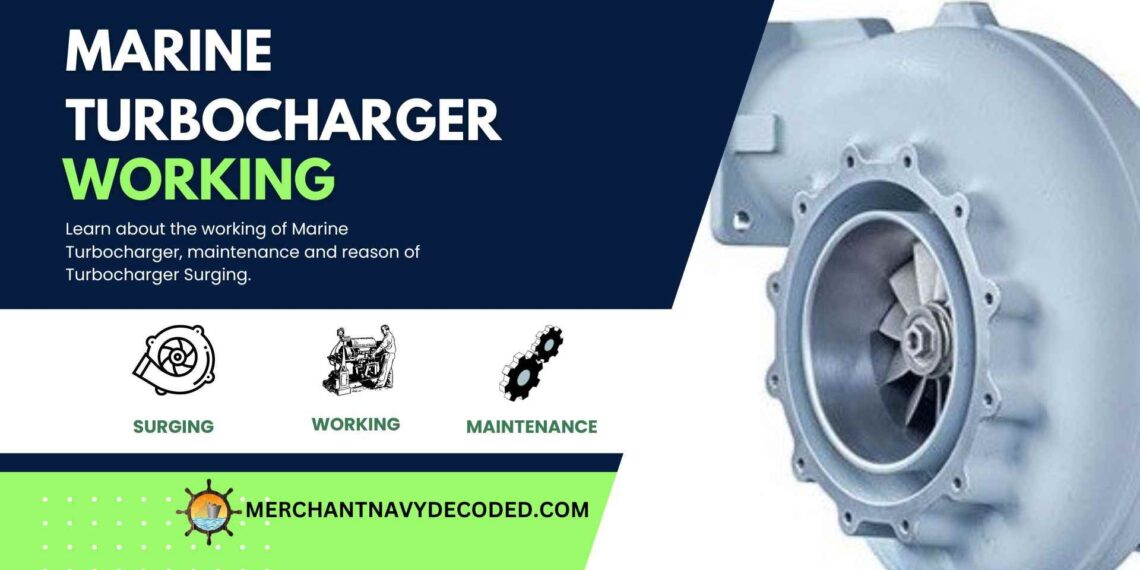Marine Turbocharger Working on Ship
1:- Overview
In the previous blog, we explored the turbocharger meaning, its construction, its various types of turbocharger on ships, and the system it operates within. In this subsequent blog, we will learn the working process of turbochargers, strategies for maintaining efficiency, and troubleshooting common issues such as surging and tuning.
2:- Marine Turbocharger Working
2.1:- Preparation and Checks of Marine Turbocharger
Prior to firing up your ship’s engine, a meticulous inspection of the turbocharger is crucial for optimal performance and longevity.
- Lube Oil Inspection
- Verify that the turbocharger’s oil reservoir (if separate) is filled to the manufacturer’s specified level.
- Confirm the oil pressure is within the normal range using the dedicated gauge.
- In the case of a shared lubrication system with the main engine, ensure the engine’s oil system is primed and ready.
- Cooling Water Verification
- Open the cooling water supply valve to the turbocharger and visually confirm the flow.
- Use a thermometer to ensure the cooling water temperature is within the manufacturer’s recommended parameters.
- Air Intake Inspection
- Thoroughly inspect the air filter for any accumulated dirt, debris, or signs of damage.
- Clean or replace the filter as needed.
- Additionally, examine the air intake duct to ensure it’s clear of obstructions that could restrict airflow.
- Visual and Manual Checks:
- Conduct a visual inspection of the entire turbocharger assembly, looking for any leaks, cracks, or loose components.
- Manually rotate the shaft (if accessible) to check for excessive play or unusual sounds.
2.2:- Starting Procedure of Marine Turbocharger
Starting a turbocharged engine requires a gentle touch to avoid stressing the components.
- Initial Start-up
- Begin by starting the engine at a low RPM, allowing the lube oil to circulate and gradually reach its optimal operating temperature.
- This gentle warm-up helps prevent thermal shock and premature wear.
- Gradual Acceleration
- Slowly increase the engine speed while carefully monitoring the turbocharger gauges.
- Keep a close watch on boost pressure, exhaust gas temperature, and bearing temperatures, ensuring they remain within the safe operating limits specified by the manufacturer.
- Auditory Vigilance:
- Listen attentively for any unusual noises coming from the turbocharger during the start-up process.
- Rattling, grinding, or squealing sounds could indicate potential issues that require immediate attention.
3:- How to Boost the Efficiency of a Turbocharger
The marine turbocharger is a masterpiece of engineering, harnessing the energy of exhaust gases to enhance engine performance.
- Exhaust Gas Utilization
- Hot, high-pressure exhaust gases exiting the engine cylinders are directed into the turbine housing.
- Turbine Rotation
- The exhaust gases impact the turbine blades, causing the turbine wheel to spin at incredibly high speeds.
- Shared Shaft
- The turbine wheel is directly connected to a compressor wheel through a common shaft.
- Air Compression
- As the turbine spins, it drives the compressor wheel, which draws in ambient air and compresses it.
- Boost Pressure
- The compressed air is then forced into the engine’s intake manifold under pressure, significantly increasing the air density within the cylinders.
- Power Amplification
- With a greater mass of air available for combustion, the engine can burn more fuel, resulting in a substantial increase in power output and overall efficiency.
4:- Turbocharger Surging on Ship

Turbocharger surging is a concerning phenomenon that can occur under certain conditions, leading to a pulsating sound and potentially damaging vibrations.
4.1:- What is Turbocharger Surging?
Marine Turbocharger Surging is a sudden and rapid reversal of airflow within the turbocharger. It happens when the compressor cannot maintain a stable pressure ratio, causing the airflow to fluctuate violently.
4.2:- Causes of Turbocharger Surging
- Abrupt Changes in Engine Load: Sudden acceleration or deceleration can disrupt the airflow, triggering turbocharger surging.
- Obstructed Air Intake or Exhaust: A clogged air filter, restricted exhaust, or a malfunctioning wastegate can lead to pressure imbalances that induce surging.
- Incorrectly Matched Turbocharger: A turbocharger that is too large for the engine can operate outside its efficient range, making it prone to surging.
4.3:- Effects of Turbocharger Surging
- Reduced Performance: Surging disrupts the smooth flow of air and fuel, reducing engine power and efficiency.
- Increased Stress: The rapid pressure fluctuations put immense stress on the turbocharger components, potentially leading to premature wear or damage.
- Noise: Surging often produces a distinctive howling or chirping sound.
4.4:- What to do in the Event of Turbocharger Surging
- Reduce Load: If surging occurs, immediately reduce the engine load to stabilize the airflow.
- Investigate and Repair: Identify and address the root cause of the surging. This may involve cleaning or replacing the air filter, checking the exhaust system, or adjusting the wastegate.
5:- Conclusion
In conclusion, marine turbochargers are essential components that significantly enhance the efficiency and performance of ship engines. Optimizing the use of exhaust gases to increase engine power, helps reduce fuel consumption and lower emissions, making maritime operations more sustainable and cost-effective.
Disclaimer :- The opinions expressed in this article belong solely to the author and may not necessarily reflect those of Merchant Navy Decoded. We cannot guarantee the accuracy of the information provided and disclaim any responsibility for it. Data and visuals used are sourced from publicly available information and may not be authenticated by any regulatory body. Reviews and comments appearing on our blogs represent the opinions of individuals and do not necessarily reflect the views of Merchant Navy Decoded. We are not responsible for any loss or damage resulting from reliance on these reviews or comments.
Reproduction, copying, sharing, or use of the article or images in any form is strictly prohibited without prior permission from both the author and Merchant Navy Decoded.


